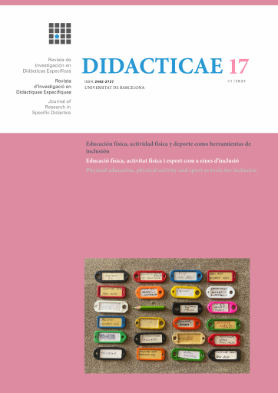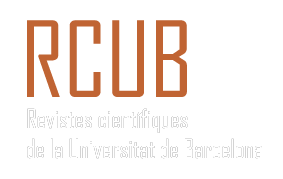Predicting academic performance in mathematics with NASA-TLX: A brief study in 15-year-old students in Spain
DOI:
https://doi.org/10.1344/did.42408Keywords:
Nasa-TLX, mathematical performance, academic performance, cognitive loadAbstract
Performance in mathematics is highly linked to the capacity for abstraction and the cognitive demands of the different exercises and problems, which is a fact to take into account when planning academic activities. The present study involving 160 15-year-old students shows that mathematics study and grades are highly correlated with mental workload. Mental workload was analyzed by means of the NASA-TLX test at the beginning of the school year, and was analyzed with the grades obtained at the end of the school year. The high correlation of the NASA-TLX test variables on mental workload, effort and performance (r = -.956***, -.944***, and -.933*** respectively) are an excellent predictor of future academic performance in mathematics grades.
References
Barkley, R. A. (1997). Behavioral inhibition, sustained attention, and executive functions: Constructing a unifying theory of ADHD. Psychological Bulletin, 121(1), 65-94. https://doi.org/10.1037/0033-2909.121.1.65
Bull, R., & Scerif, G. (2001). Executive functioning as a predictor of children’s mathematics ability: Inhibition, switching, and working memory. Developmental Neuropsychology, 19(3), 273-293. https://doi.org/10.1207/s15326942dn1903_3
Calhoon, M. B., & Fuchs, L. S. (2003). The effects of peer-assisted learning strategies on the mathematics performance of secondary students with disabilities [Electronic version]. Remedial and Special Education, 24, 235-245. https://psycnet.apa.org/doi/10.1177/07419325030240040601
Chen, O., Paas, F., & Sweller, J. (2023). A cognitive load theory approach to defining and measuring task complexity through element interactivity. Educational Psychology Review, 35(2), 63. https://doi.org/10.1007/s10648-023-09782-w
Cowan, N. (2010). The magical mystery four how is working memory capacity limited, and why? Current Directions in Psychological Science, 19(1), 51-57. https://doi.org/10.1177/0963721409359277
Dziuban, C. D., & Shirkey, E. C. (1974). When is a correlation matrix appropriate for factor analysis? Some decision rules. Psychological bulletin, 81(6), 358.
Gallistel, C. R., & Gelman, R. (2005). Mathematical cognition. Cambridge University Press.
Ganor-Stern, D. (2016). Solving math problems approximately: A developmental perspective. PLoS One, 11(5), e0155515. https://doi.org/10.1371/journal.pone.0155515
Gilmore, C., Göbel, S. M., & Inglis, M. (2018). An introduction to mathematical cognition. Routledge.
Hart, S. G., & Staveland, L. E. (1988). Development of NASA-TLX (Task Load Index): Results of empirical and theoretical research. In P. A. Hancock & N. Meshkati (Eds.), Human mental workload (pp. 139-183). Springer. https://doi.org/10.1016/S0166-4115(08)62386-9
Hollender, N., Hofmann, C., Deneke, M., & Schmitz, B. (2010). Integrating cognitive load theory and concepts of human–computer interaction. Computers in Human Behavior, 26(6), 1278-1288. https://psycnet.apa.org/doi/10.1016/j.chb.2010.05.031
Kirschner, P. A., Sweller, J., & Clark, R. E. (2006). Why minimal guidance during instruction does not work: An analysis of the failure of constructivist, discovery, problem-based, experiential, and inquiry-based teaching. Educational Psychologist, 41(2), 75-86. https://doi.org/10.1207/s15326985ep4102_1
Lee, K., & Bull, R. (2016). Developmental changes in working memory, updating, and math achievement. Journal of Educational Psychology, 108(6), 869-882. https://psycnet.apa.org/doi/10.1037/edu0000090
Mateu, M., Nieto, P. & Pizà-Mir, B. (2022). Efectos del ejercicio y condición física sobre la atención en población infantil de 5 años: una prueba piloto. Academic Journal of Health Science, 37(6), 64-67. http://doi.org/10.3306/AJHS.2022.37.06.64
Menon, V. (2016). Memory and cognitive control circuits in mathematical cognition and learning. Progress in Brain Research, 227, 159-186. https://doi.org/10.1016/bs.pbr.2016.04.026
Morrison, G. R., & Anglin, G. J. (2005). Research on cognitive load theory: Application to e-learning. Educational Technology Research and Development, 53(3), 94-104. https://doi.org/10.1007/BF02504801
Mull, C. A., & Sitlington, P. L. (2003). The role of technology in the transition to postsecondary education of students with learning disabilities: A review of the literature. The Journal of Special Education, 37(1), 26-32. https://doi.org/10.1177/00224669030370010301
Nicolau, A., Nieto, P. & Pizà-Mir, B. (2022). Efectos del ejercicio y condición física sobre la atención en población escolar juvenil: una prueba piloto. Academic Journal of Health Science, 37(5), 17-21. http://doi.org/10.3306/AJHS.2022.37.05.17
Paas, F., & Sweller, J. (2012). An evolutionary upgrade of cognitive load theory: Using the human motor system and collaboration to support the learning of complex cognitive tasks. Educational Psychology Review, 24, 27-45. https://doi.org/10.1007/s10648-011-9179-2
Pizà-Mir, B. (2022a). Diseño curricular según la taxonomía revisada de Bloom: Matemáticas en primaria y secundaria. En L. Molina García, D. Cobos Sanchiz, E. López Meneses, A. Jaén Martínez y A. Hilario Martín Padilla (Coords.), Educación y Sociedad: Pensamiento e Innovación para la transformación social (pp.1405-1411). Dykinson. S.L
Pizà-Mir, B. (2022b). El diseño de pruebas de evaluación objetivas según la taxonomía revisada de Bloom (RBT) y su efecto sobre el aprendizaje y relación con la ansiedad en asignaturas con componente matemático: Una prueba piloto. En P. J. Ruiz
Montero, A. Baena Extremera, D. Aguilera Morales y R. Martín Moya (Eds.), Importancia de un aprendizaje competencial, transversal y cultural para un óptimo desarrollo educativo (pp. 89-104). Editorial Wanceulen S.L.
Pizà-Mir, B., Benito Colio, B., Rodríguez-García, L., & González-Fernández, F. T. (2022). Physical exercise based on active breaks on cognitive function and mathematical competence in undergraduate students. Retos, 45, 970–977. https://doi.org/10.47197/retos.v45i0.92669
Pizà-Mir, B., Moreno-Vecino, B., & Monserrat-Monserrat, M. V. (2023). Interès del professorat d’ensenyaments no universitaris en projectes de recerca educativa. REIRE Revista d'Innovació i Recerca en Educació, 16(2), 1-13. https://doi.org/10.1344/reire.42438
Pizà-Mir, B., & Suñé-Vela, M. (2022). Competencia matemática y su autopercepción en estudiantes de los grados universitarios de educación. Journal of Research in Mathematics Education, 11(3), 250-267. http://dx.doi.org/10.17583/redimat.10271
Renkl, A., Hilbert, T., & Schworm, S. (2009). Example-based learning in heuristic domains: A cognitive load theory account. Educational Psychology Review, 21(1), 67-78. https://psycnet.apa.org/doi/10.1007/s10648-008-9093-4
Schnotz, W., & Kürschner C. (2007). A reconsideration of cognitive load theory. Educational Psychology Review, 19, 469–508. https://psycnet.apa.org/doi/10.1007/s10648-007-9053-4
Swanson, H. L. (2004). Working memory and phonological processing as predictors of children’s mathematical problem solving at different ages. Memory & Cognition, 32, 648-661. https://doi.org/10.3758/BF03195856
Sweller, J., Van Merriënboer, J. J., & Paas, F. G. (1998). Cognitive architecture and instructional design. Educational Psychology Review, 10(3), 251-296. https://doi.org/10.1023/A:1022193728205
Tobias, S., & Carlson, J. E. (1969). Brief report: Bartlett's test of sphericity and chance findings in factor analysis. Multivariate Behavioral Research, 4(3), 375-377. https://psycnet.apa.org/doi/10.1207/s15327906mbr0403_8
Van Merriënboer, J. J. & Sweller, J. (2005). Cognitive load theory and complex learning: Recent developments and future directions. Educational Psychology Review, 17(2), 147-177. https://doi.org/10.1007/s10648-005-3951-0
Wehmeyer, M. L., Smith, S. J., Palmer, S. B., & Davies, D. K. (2004). Technology use by students with intellectual disabilities: An overview. Journal of Special Education Technology, 19(4), 7-21. https://doi.org/10.1177/016264340401900402
Downloads
Published
Issue
Section
License
Copyright (c) 2023 Arturo Quílez-Maimón, Bartolomé Pizà-Mir

This work is licensed under a Creative Commons Attribution-ShareAlike 4.0 International License.
The authors who publish in this journal agree to the following terms:
- Authors retain copyright and grant the journal the right of first publication.
- Submitting a paper does not involve paying any fees.
- Texts will be published under a Creative Commons Attribution Share-Alike 4.0 International License that allows others to share the work, provided they include an acknowledgement of the work’s authorship, its initial publication in this journal and the terms of the license.
- When citing works published in Didacticae, both the autor and the journal must be cited.
- Didacticae does not accept any responsibility for the points of view and statements made by the authors.



